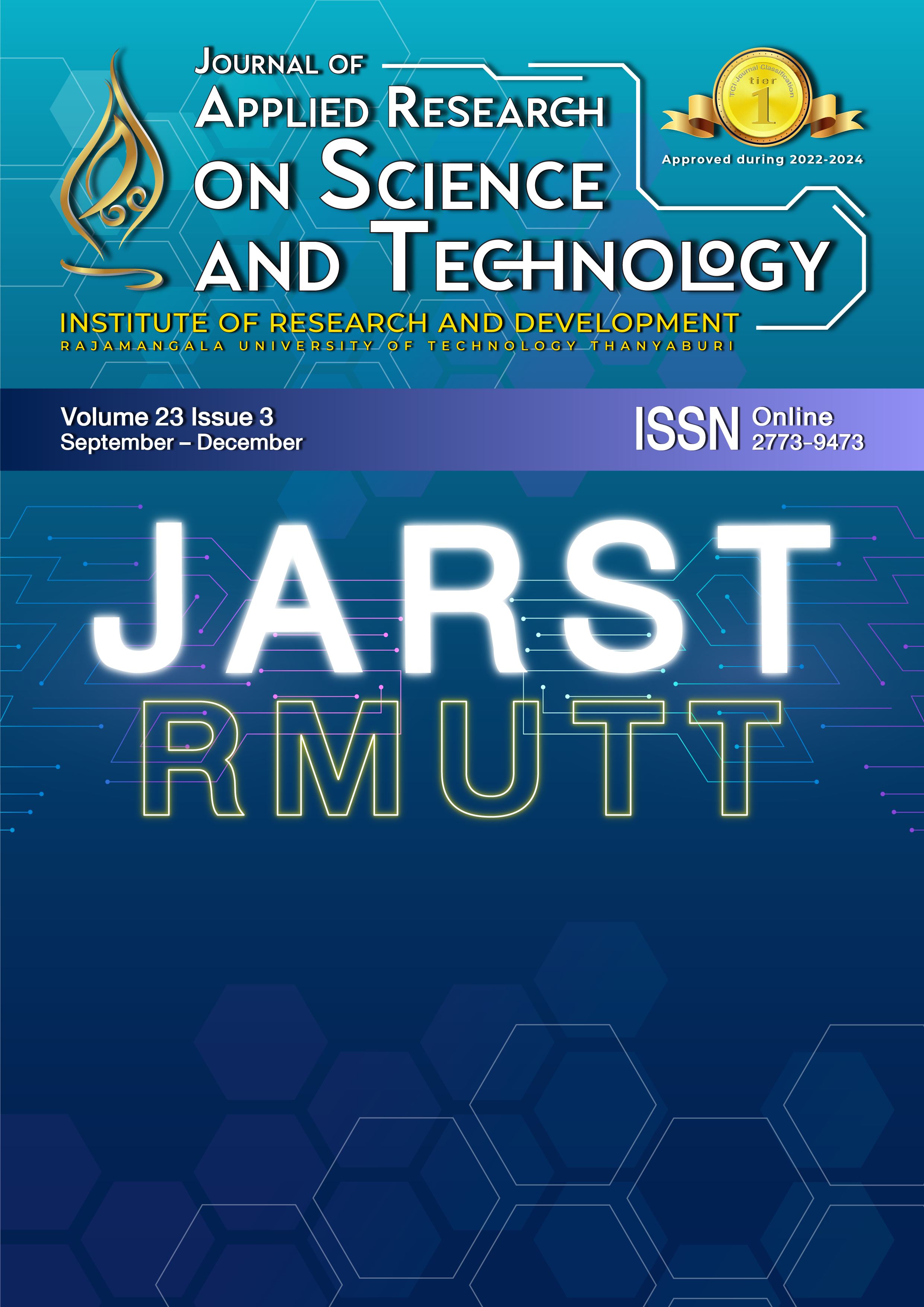A study on the behavior of pulling power and flammability of mold walls mixed with high-density polyethylene plastic waste
Main Article Content
Abstract
Currently, materials used in construction have been continuously developed in terms of quality and efficiency, especially fiber reinforcement in mortar, a form of development used in construction. The development aims to enhance concrete's tensile properties and performance for higher flexibility. Most plaster walls are ordinary mortar and have low elasticity, which is a weak point. Therefore, attempts are being made to improve their properties by using a rigid material as a concrete mixture, namely high-density polyethylene plastic, to increase its ability to bear tensile force. This study examines the tensile strength and flammability tests of walls plastered with mortar, with which high-density polyethylene plastic waste is mixed. The tensile strength of mortar plaster walls mixed with high-density polyethylene plastic is tested by replacing at 2.5%, 5%, and 10% proportions and cured at 7, 14, and 28 days. By comparing general mortar and high-density polyethylene plastic mortar, it is found that the general mortar had the highest tensile strength at 28 days of curing. The obtained value is 45 ksc, and the mortar mixed with polyethylene plastic in the amount of 2.5% at 28 days of curing can withstand the strength of 45 ksc. In addition, the general mortar can produce the same tensile strength as mortar mixed with high-density polyethylene plastic. The flammability test shows that general mortar develops red marks after being burned with fire, while the mortar combined with high-density polyethylene plastic develops black marks. However, neither type of wall is in flames nor spread.
Article Details

This work is licensed under a Creative Commons Attribution-NonCommercial-NoDerivatives 4.0 International License.
References
Bhogayata A, Arora N. Feasibility study on using metalized plastic waste in concrete. In: Proceedings of Conference on International Congress and Exhibition. 2018 Jul 1; Springer; 2017. p. 328-37.
Batayneh M, Marie l, Asi l. Use of selected waste materials in concrete mixes. Waste Manage. 2007;27(12):1870-6.
Badache A, Benosman A, Senhadji Y, Mouli M. Thermo-physical and mechanical characteristics of sand-based lightweight composite mortars with recycled high-density polyethylene (HDPE). Constr Build Mater. 2018;163:40-52.
Apised S, Teerin k, Maneerat k. Properties of Mortar Composites from Plastic Waste. Journal of Applied Science and Engineering. 2021;25(1):59-70.
Mentes D, Nagy G, Szab T, Hornyk E, Fiser B, Viskolcz B, et al. Combustion behavior of plastic waste - A case study of P.P., HDPE, PET, and mixed PES-EL. J Clean Prod. 2023;402:136850.
Chen Y, Awasthi A, Wei F, Tan Q, Li J. Single-use plastics: production, usage, disposal, and adverse impacts. Sci Total Environ. 2021;752:141772.
Pichetsilpa K. A Guideline for Building Wall System to Improve Thermal Performance [dissertation]. Bangkok: Chulalongkorn University; 2002.
ASTM C136-06, Standard Test Method for Sieve Analysis of Fine and Coarse Aggregates. West Conshohocken, PA: ASTM International; 2006.
ASTM C642-13, Standard Test Method for Density, Absorption, and Voids in Hardened Concrete. West Conshohocken, PA: ASTM International; 2013.
ASTM C230/C230 M-14, Standard specification for flow table for use in tests of hydraulic cement. West Conshohocken, PA: ASTM International; 2014.
ASTM C190, Standard test method for Tensile Strength of hydraulic cement mortars. West Conshohocken, PA: ASTM International; 1985.
Rongviriyapanich O. Chemical physical and mechanical properties of oven-dried mortar after fire exposure [dissertation]. Bangkok: Chulalongkorn University; 2012.
Nibudey N, Nagarnaik B, Parbat K, Pande M. A model for compressive strength of PET fiber reinforced concrete. American Journal of Engineering Research (AJER). 2013;2(12):367-72.
Posee V, Suhaya H, Abedeen D. Heat transfer of non-load-bearing interlocking block with mixture of Para Rubber wood fly ash. J Res Unit Sci Technol Environ. 2013;4(1):1-6.
Panthapulakkal S, Sain M. Injection-molded short hemp fiber/glass fiber-reinforced polypropylene hybrid composites - Mechanical, water absorption and thermal properties. J Appl Polym Sci. 2007;103:2432-41.
Chen C, Yang Y, Zhou Y, Xue C, Chen X, Wu H, et al. Comparative analysis of natural fiber reinforced polymer and carbon fiber reinforced polymer in strengthening of reinforced concrete beams. J Clean Prod. 2020;263(2):121572.
Hung CC, Chang JN, Wang HY, Wen FL. Effect of adding waste polyethylene and GGBFS on the engineering properties of cement mortar. Appl Sci. 2022;12:12665.
Chumnandee K. A comparison of insulation installation on the inside and outside of walls for cooling energy efficiency [dissertation]. Bangkok: Chulalongkorn University; 2011.
Qamar F, Thomas T, Ali M. Improvement in lateral resistance of mortar-free interlocking wall with plaster having natural fibres. Constr Build Mater. 2020;234:117387.
Garas G, Allam M, Mamdouh K. Straw bale fire test on cement plaster mixes. WIT Trans Built Env. 2009;108:51-9.
Suwan T, Wattanachai P. Properties and internal curing of concrete containing recycled autoclaved aerated lightweight concrete as aggregate. Adv Mater Sci Eng. 2017;8:1-11.
Rupasinghe N, Sathiparan N. Mechanical behavior of masonry strengthened with coir fiber reinforced hydraulic cement mortar as surface plaster. Journal of Structural Engineering & Applied Mechanics. 2019;2(1):12-24.
Yatim M, Mohammadhossein H. Evaluation of the effective mechanical properties of concrete composites using industrial waste carpet fiber. Springer Link INAE Lett. 2017;2:1-12.
Meng B, Xu J, Lou C, Gu C, Peng G. Effect of water content on tensile properties of cement mortar. In: 2018 International Conference on Civil and Hydraulic Engineering; 2018 Nov 23-25; p. 189-98.
Triantafillou T, Karlos K, Kefalou K, Argyropoulou E. An innovative structural and energy retrofitting system for URM walls using textile reinforced mortars combined with thermal insulation. Mechanical and fire behavior, Constr Build Mater. 2017;133:1-13.


